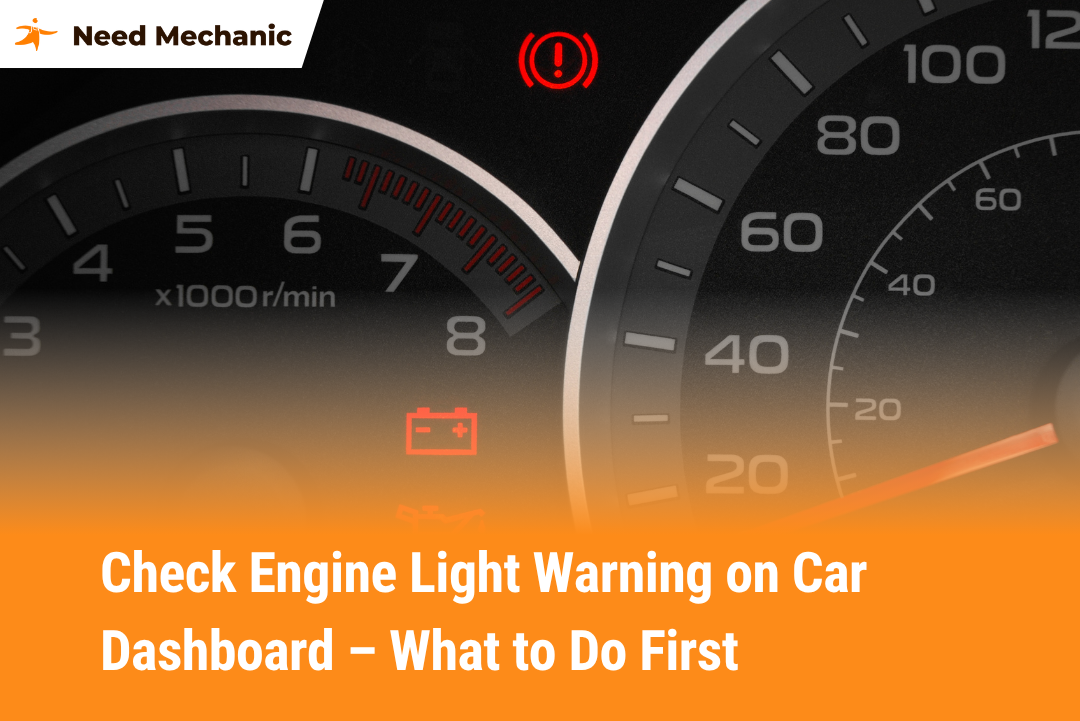Your car’s check engine light can be unsettling. That little warning lamp could mean something minor, like a loose gas cap, or something more serious, like a failing sensor. Knowing what to do first can save you time, money, and stress. This article walks you through why that light comes on, what simple steps you can take right away, and when it’s time to seek professional help. By the end, you’ll feel confident handling a check engine warning and getting back on the road safely.
Table of Contents
What the Check Engine Light Means
The check engine light, also called the malfunction indicator lamp (MIL), lives on your dashboard. It’s part of your car’s onboard diagnostics system (OBD-II). When a sensor detects something outside normal ranges—like too much fuel, low oxygen, or high emissions—the light comes on.
Modern cars have dozens of sensors feeding data to the engine control unit (ECU). The ECU compares this data to set standards. If it spots a fault, it stores a trouble code and lights up the lamp. You won’t see the code itself, but a technician can read it with an OBD-II scanner.
A steady light means there’s a problem that needs attention soon. A blinking light signals a more urgent issue, often related to engine misfires. Ignoring it could damage parts like the catalytic converter or leave you stranded.
Common Reasons Your Check Engine Light Is On
The check engine light can be triggered by dozens of issues, but some are far more common than others. Knowing these can help you figure out whether it’s a quick fix or something that needs a professional’s touch. Here are the top culprits people search for when their check engine light won’t go away:
1. Loose or Faulty Gas Cap
A loose, damaged, or missing gas cap is one of the most frequent reasons for a check engine light. Your car’s fuel system needs to be sealed to maintain proper pressure and emissions. If the gas cap isn’t tight or its seal is broken, the system detects a leak, and the light comes on.
- Why it matters: A loose gas cap can reduce fuel efficiency and release harmful emissions. Fixing it is as simple as tightening or replacing the cap, saving you from unnecessary repair costs.
2. Oxygen Sensor Failure
Oxygen sensors (O2 sensors) measure the amount of oxygen in your exhaust to ensure the engine runs efficiently. A faulty O2 sensor can throw off your car’s fuel-air mix, leading to poor gas mileage or rough performance.
- Why it matters: Ignoring a bad O2 sensor can damage your catalytic converter, which is an expensive repair. Replacing the sensor early can save you hundreds of dollars and keep your car running smoothly.
3. Catalytic Converter Issues
The catalytic converter reduces harmful emissions by converting exhaust gases into less toxic substances. If it’s clogged or failing, your check engine light will likely turn on, and you might notice sluggish acceleration or a sulfur-like smell.
- Why it matters: A failing catalytic converter can lead to failed emissions tests and reduced fuel economy. Addressing it quickly can prevent further engine damage and keep you compliant with local regulations.
4. Spark Plug or Ignition Coil Problems
Spark plugs and ignition coils are critical for igniting the fuel in your engine. Worn-out spark plugs or faulty coils can cause misfires, rough idling, or difficulty starting your car.
- Why it matters: Misfires can strain your engine and lower fuel efficiency. Replacing spark plugs is a relatively affordable fix that restores smooth performance and prevents bigger issues.
5. Mass Airflow Sensor (MAF) Failure
The MAF sensor measures the air entering your engine to optimize fuel delivery. A dirty or broken MAF sensor can cause poor acceleration, stalling, or even trouble starting the car.
- Why it matters: A faulty MAF sensor can reduce fuel economy and make driving less safe. Cleaning or replacing it can get your car back to peak performance.
These are just a few of the reasons your check engine light might be on. Others include faulty thermostats, bad wiring, or even low oil pressure. The key is to narrow down the issue without guessing blindly, which brings us to the first steps you should take.
What to Do First When Your Check Engine Light Comes On
Seeing that check engine light can feel overwhelming, especially if you’re not sure what’s wrong. But don’t worry—there are simple, practical steps you can take to diagnose the problem and decide your next move. Here’s what to do first when your check engine light turns on:
Step 1: Check for Obvious Issues
Start with the easiest fix: your gas cap. After filling up, did you tighten it until it clicked? A loose or damaged gas cap is an easy problem to solve. Remove it, inspect the seal for cracks, and screw it back on securely. Drive for a day or two—if the light goes off, you’ve likely fixed the issue.
- Pro tip: If the gas cap is damaged, replace it with one that matches your car’s make and model. They’re inexpensive and widely available at auto parts stores.
Step 2: Observe Your Car’s Behavior
Pay attention to how your car is running. Is it idling roughly, losing power, or making strange noises? Are you noticing worse gas mileage or trouble starting? These clues can help you or a mechanic pinpoint the problem. For example:
- Rough idling or stalling: Could point to spark plug or MAF sensor issues.
- Poor acceleration: Might indicate a catalytic converter or O2 sensor problem.
- No symptoms at all: Often a minor issue like a gas cap or a one-time glitch.
Step 3: Use an OBD-II Scanner
An OBD-II scanner is a small device that plugs into your car’s diagnostic port (usually under the dashboard) and reads the error code causing the check engine light. These codes, like P0300 (misfire) or P0420 (catalytic converter), give you a specific starting point.
- Why it’s worth it: Scanners are affordable (starting at $20), and many auto parts stores like AutoZone or O’Reilly will scan your car for free. Once you have the code, you can look it up online or share it with a mechanic to avoid guesswork.
How to do it:
- Buy or borrow an OBD-II scanner or visit an auto parts store.
- Plug the scanner into the OBD-II port.
- Turn your car’s ignition to “on” without starting the engine.
- Follow the scanner’s instructions to retrieve the code.
- Search the code online (e.g., “P0300 code meaning”) for details.
Step 4: Decide Whether to DIY or See a Mechanic
Some issues, like a loose gas cap or worn spark plugs, are easy enough for beginners to fix with basic tools. Others, like a catalytic converter or O2 sensor replacement, often require professional skills and equipment. Use the error code and your observations to decide:
- DIY-friendly fixes: Gas cap, air filter, or spark plug replacement.
- Mechanic-needed fixes: Catalytic converter, O2 sensor, or complex wiring issues.
Step 5: Don’t Ignore It
Ignoring the check engine light can turn a small problem into a big one. A minor issue like a faulty O2 sensor can damage your catalytic converter, costing thousands to replace. Acting quickly saves money and keeps your car reliable.
How to Prevent Check Engine Light Problems
Prevention is the best way to avoid the stress of a check engine light. By taking care of your car, you can reduce the chances of issues popping up. Here are practical tips to keep your vehicle in top shape:
1. Follow Regular Maintenance
Stick to your car’s maintenance schedule, outlined in the owner’s manual. Regular oil changes, air filter replacements, and spark plug checks keep your engine running smoothly and reduce the risk of problems.
- User benefit: Routine maintenance saves you from unexpected breakdowns and costly repairs.
2. Use Quality Fuel
Low-quality or contaminated fuel can clog injectors or harm sensors, triggering the check engine light. Stick to reputable gas stations and use the fuel grade recommended by your car’s manufacturer.
- User benefit: Better fuel means better performance and fewer trips to the mechanic.
3. Keep an Eye on Warning Signs
Don’t wait for the check engine light to act. If you notice poor gas mileage, strange noises, or sluggish performance, address it early. Catching problems before the light comes on can save you time and money.
- User benefit: Proactive care keeps your car reliable and your wallet happy.
4. Store an OBD-II Scanner
Having your own OBD-II scanner means you can check codes anytime the light comes on. It’s a small investment that gives you confidence and control over your car’s health.
When to Seek Professional Help
While some check engine light issues are easy to fix, others require a professional’s expertise. Here’s when to head to a mechanic:
- The light is flashing: A flashing check engine light usually means a serious issue, like a severe misfire, that could damage your engine. Don’t drive far—get to a mechanic ASAP.
- You’ve tried simple fixes: If tightening the gas cap or resetting the light doesn’t work, it’s time for a pro to take a look.
- Complex codes appear: Codes related to the catalytic converter, transmission, or emissions system often need specialized tools and skills.
- You’re not comfortable with DIY: If you’re unsure about fixing spark plugs or sensors, a mechanic can save you from costly mistakes.
Check online reviews and ask for a clear explanation of the problem and repair costs before agreeing to work.
Why Addressing the Check Engine Light Matters
Dealing with a check engine light isn’t just about turning it off—it’s about keeping your car safe, efficient, and reliable. Ignoring it can lead to:
- Higher repair costs: Small issues like a bad sensor can escalate into major damage, like a failed catalytic converter.
- Failed emissions tests: Many states require emissions checks for registration. A check engine light often means an automatic fail.
- Poor fuel economy: Faulty sensors or misfires can burn more gas, hitting your wallet at the pump.
- Safety risks: Some issues, like stalling or loss of power, can make driving dangerous.
By acting quickly, you save money, avoid breakdowns, and keep your car running like it should. Plus, you’ll have peace of mind knowing you’re on top of your vehicle’s health.
Conclusion
Your check engine light doesn’t have to be a mystery or a money pit. By understanding common causes like a loose gas cap, faulty O2 sensor, or spark plug issues, you can take control of the situation. Start with simple checks, use an OBD-II scanner to get answers, and know when to call in a professional. Regular maintenance and quick action are your best tools for keeping your car reliable and your repair bills low. Next time that light comes on, you’ll know exactly what to do first—saving you time, money, and stress.
FAQs
What does it mean if my check engine light is blinking?
A blinking check engine light means a serious problem like an engine misfire that can harm your catalytic converter. Stop driving right away and have a mechanic or OBD-II scanner diagnose it to avoid costly damage.
Can I drive when the check engine light is on?
If the light stays on steadily, you can drive a short distance but scan and fix it soon to avoid bigger engine or emissions damage. If it blinks, pull over immediately—continuing to drive can harm your engine or converter.
How much to fix a check engine light issue?
Costs vary widely: a loose gas cap is under $10; spark plugs or O₂ sensors run $50–200. A catalytic converter replacement can cost $400–2,500+ depending on your vehicle model and labor rates.
Why won’t my check engine light turn off after gas cap?
After tightening or replacing a loose gas cap, the ECU may need a few drive cycles (often 1–3 days) to reset. If it stays on longer, check the cap’s seal for damage, replace it if needed, or scan and clear the code with a reader.
How do I read check engine light codes free?
Many auto parts stores offer free OBD-II code scans. You can also borrow or buy an inexpensive OBD-II scanner, plug it into the port under your dash, and read the DTCs yourself for a straightforward DIY diagnosis.
Will tightening my gas cap reset the check engine light?
Yes—a loose gas cap often triggers the light. Tighten it until you hear a click and drive a few minutes or complete a couple of drive cycles. If it doesn’t clear, inspect or replace the cap and then re-scan for codes to reset the light.
What causes P0420 code on check engine light?
Code P0420 means “Catalyst System Efficiency Below Threshold.” It usually indicates a failing catalytic converter or a bad O₂ sensor. Replacing the sensor or the converter restores proper emissions performance.
How long can I drive with the check engine light on?
With a steady light and no odd symptoms, you can drive short distances to a repair shop. But scan and fix the issue promptly. If it’s flashing or you notice strange smells or sounds, stop driving immediately for safety.




Leave a Reply